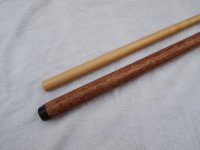I've got a small collection of 7 pool cues and around 12 different shafts and I have 32 snooker cues and all the snooker cues generate more spin on the CB. Why would this be? All the snooker cues have an Elkmaster tip, with the exception of 1 which has a Kamui Black SS. All the pool cues have a Kamui Black SS installed.
Its been bugging me for a while and I just can't figure it out. Perhaps its the way I apply english? In both instances I just get down with my tip already placed at the part of the CB I want to strike, but I took notice when doing this recently. With the pool cues its similar to a mix of BHE and FHE, whereas the snooker cues are closer to parallel english. Could this be why?
If anyone could shed some light on why certain cues have the capability to generate more spin I'd be grateful.
Cheers.
Its been bugging me for a while and I just can't figure it out. Perhaps its the way I apply english? In both instances I just get down with my tip already placed at the part of the CB I want to strike, but I took notice when doing this recently. With the pool cues its similar to a mix of BHE and FHE, whereas the snooker cues are closer to parallel english. Could this be why?
If anyone could shed some light on why certain cues have the capability to generate more spin I'd be grateful.
Cheers.
